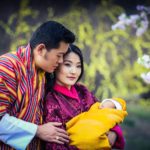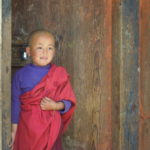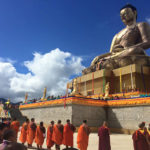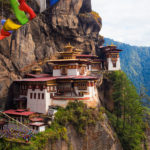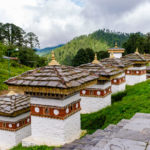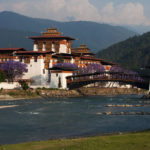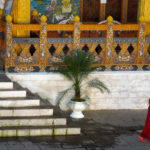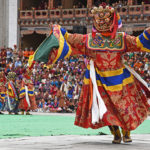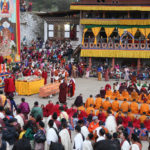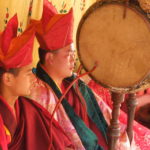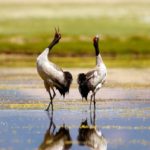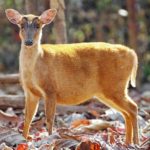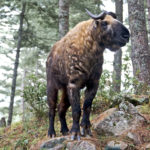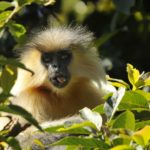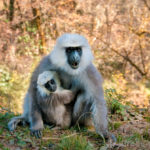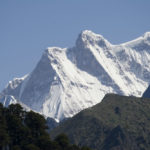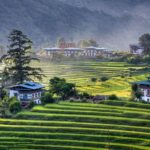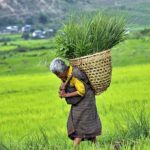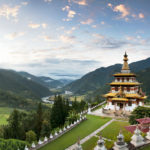FEATURED TRIP
Bhutan - Indigenous Monpas 2018
- Destination Overview
- Photo Gallery
- Itinerary
- Dates, Prices & Services
- Documents
- Trip Planner
- Online Payment
-
Destination Overview:
Monpas
In central Bhutan, south of Trongsa, scattered on the slopes of the Mangde Chhu valley, live the Monpas, believed to be the first inhabitants of Bhutan. Spiritual guidance is a blend of animistic Shamanism and Buddhism and livelihood depends on the bounty of the forest. A close-knit people, they live in small bamboo thatch huts and also larger traditional homes. Monpas believe that sickness is caused by evil spirits and bad karma and prefer superstitious and traditional cures.
Tribal Trust Foundation
An advocate for indigenous peoples, the Tribal Trust Foundation (TTF) has been documenting ancient ways of life before they disappear, for nearly twenty years. The TTF has helped complete various media projects to use as tools for cultural preservation, which saves lives and revitalizes endangered cultures. These projects include documentation of the way of life of the San Bushmen in Namibia, the Mbuti in the Democratic Republic of the Congo, and the Monpas of Central Bhutan.
The Monpa have lived sustainable in the Himalaya for thousands of years. The elders are concerned their language and customs are disappearing as change is forced upon them. The TTF partnered with the Tarayana Foundation to document the Monpa Natural Healer’s ancient wisdom and also implement grassroots sustainable projects with the Monpa.
http://www.tribaltrustfoundation.org/
Bhutan:
Trongsa Area:
-
Photo Gallery
-
Itinerary
Day 1 (December 2) - Arrive Paro
As we approach Bhutan, we see the massive peaks of the eastern Himalaya, including Kanchenjunga, the world’s third highest peak, and Jhomolhari, Bhutan’s holy mountain. Upon arrival in the Paro Valley and after completing visa formalities, your Bhutanese guide and driver will be waiting outside of the terminal to receive and escort you to our accommodations for the evening.
We begin our spiritual journey with a powerful butter lamp lighting ceremony at the 8th Century Kyichu Temple. The ceremony is performed to embark on a journeys with safe passage throughout the kingdom. We will then stretch our legs on a short walk/hike back to our hotel following a farm road.
In the evening we will have an orientation and Welcome Dinner.
Overnight Paro (7,382 ft.)
L, DDay 2 (December 3) - Explore Paro Valley
Paro lies on the banks of the Pa Chhu (chhu means “river”), which winds through the bucolic Paro Valley, once the hub for trade with Tibet. Our first stop is the Paro Rimpung Dzong. We’ll ascend a short hill behind the dzong to reach the Ta Dzong, a circular fortress that once protected this valley from Tibetan invasion. The impressive watchtower commands sweeping views of the valley below. It used to house Bhutan’s National Museum, which, since 1968, has been the home of the country’s most cherished relics.
We will also hike to the less travelled Zuri Dzong which dates back to the 14th Century and houses the temples to the local protective deities. This temple complex originally served as a fortress, perched high on a hill, protected by sheer cliffs and extensive high walls. It has a semblance to a moat with legends of holy water. There are accounts of this being used as armory and granary for the main dzong after the 17th Century. Presently, it houses hermits and scholars that specialize in indigenous medicine. Our hike is relatively easy and will be rewarded with great views of the town below.
Towards the evening, we explore Paro town and its various handicraft and souvenir shops.
Overnight Paro (7,382 ft.)
B, L, D
Day 3 (December 4) - Fly Paro to Bumthang, Spiritual Heartland
This morning we take a short mountain flight to Bumthang. This flight offers spectacular views of the Himalayas and the valleys beneath crafted by the rivers that flow from the glaciers forming rich and fertile lands for settlements. To the right of the plain, the Black Mountain range is prominent. At the foothills of it lies the Monpa land that we shall visit in the next few days.
Once in Jakar Valley, we check into our hotel and freshen up. We then explore the 7th Century Jampa Temple and onwards to Kurje Lhakhang, where three temples are surrounded by 108 stupas. From Kurje we set off on foot to Tamshing Lhakhang, founded in 1501 by Pema Lingpa, a blacksmith from Bumthang who became one of Bhutan’s most revered Buddhist saints and teachers. Our walk wraps up at the Swiss Farm, a development project started in the 1960s when Swiss cheese-maker Fritz Maurer brought his skills to Bhutan.
Overnight Bhumtang (9,185 ft.)
B, L, DDay 4 (December 5) - Explore Bumthang, Spiritual Heartland
After a delicious breakfast, we drive a couple of hours to arrive in the buckwheat growing valley of Tang, one of the four valleys of Bumthang. Tang combines immense natural beauty with a history of hosting the greatest collection of eminent spiritual practitioners. One such spiritual leader, Longchen Rabjam, and his descendants have built the Ogyenchholing, the palace of bliss. We will take a tour of this now private museum.
En route we visit the Pemachholing Nunnery, home to ~300 Buddhist nuns and practitioners of the powerful drum ceremony. The hymns from the Buddhist text are sang in tune with the hand-held drum and bell. We may interact with some of the few English-speaking nuns to understand their ordained lives and their choice to live in celibacy.
We have an opportunity for a short hike to the Burning lake, or Mebartsho, where the king of treasure revealers, Pema Lingpa, is said to have performed his first miracle.
Overnight Bhumtang (9,185 ft.)
B, L, DDay 5 (December 6) - Bumthang to Trongsa to Jangbi
We drive from Bumthang to Trongsa across the Yutong La (la means “pass”) of 11,300 ft. Our 2-hour journey on the newly constructed road is scenic and may have some wildlife sightings. Reaching the bustling village of Trongsa, we proceed further south for about 3 hours, taking a farm road to the village of Jangbi. Jangbi is where the Monpa reside and is our home for the next two nights.
Our Bhutanes guide will present a camp orientation. We will be welcomed by the local community of Monpa people, led by the resident Buddhist monk. The Monpas practiced Bon or Shamanism long before the advent of Buddhism. The resident monk has been appointed by the government, due to the scarcity of the shamans and bon masters, to benefit the people in their spiritual pursuit of happiness. The few shaman masters do visit this village, reach out to the spirit world and channel these transcendental energies into the lives of the Monpas.
Overnight Jangbi Camp (3,500 ft.)
B, L, DDay 6 (December 7) - Explore Jangbi's Monpa Village & Daily Life
Today is an exciting day for us in the Monpa community! We peek into the lives of the Monpa people through firsthand experience. Our activities include visiting homes, participating in various farm tasks and interacting with the Monpa people.
In gratitude for sharing their lives with us, we will cook a dinner for them. Our camp cooks will guide you through hand-written recipes to prepare local dishes such as the ema datse, butter tea and other local favorites. We will all participate in preparing food for the Monpas to enjoy this evening. After a sumptuous meal, the Monpas will proudly demonstrate their traditional Monpa tribal dance.
Overnight Jangbi Camp (3,500 ft.)
B, L, DDay 7 (December 8) - Jangbi to Trongsa, Birthplace of Monarchy
We bid farewell to our newfound Monpa family in Jangbi and retrace our journey back to Trongsa. In Trongsa, we visit the Monarchy Museum housed in the Trongsa Taa Dzong, or watchtower. This watchtower stands on a promontory above the town and once guarded Trongsa Dzong from internal rebellion. Built in the 17th Century, it houses a shrine dedicated to the epic hero, King Gesar of Ling. The watchtower was converted into a museum dedicated to the monarchies of Bhutan and provides an insight into the significance of Trongsa in Bhutan’s history.
Overnight Trongsa (7,215 ft.)
B, L, DDay 8 (December 9) - Trongsa to Gangtey and Phobjikha Valley
We depart for the stunning Phobjikha Valley. Our route of ~ three (3) hours climbs from the subtropical greenery of Trongsa to alpine regions featuring vast hemlock and rhododendron forests. Gangtey Valley is home to the endangered black-necked cranes and the conservation efforts of Bhutan and WWF have created a safe haven for these beautiful birds which flock the marshy wetlands in winter for roosting.
After arriving and a delectable lunch, we will undertake a short hike around the valley observing the beauty of the glacial valley, its inhabitants and the black-necked cranes.
Overnight Gangtey (9,510 ft.)
B, L, DDay 9 (December 10) - Gangtey to Punakha, Ancient Capital
Our drive to Punakha, the ancient Capital of Bhutan, is quite scenic. You will notice the change in vegetation from alpine highland to cactus-growing rich vallies of Wangdi and Punakha. En route to Punakha, we will enjoy a short hike to the Chimi Lhakhang, a temple dedicated to the Divine Mad Monk- Drukpa Kuenley. Your guide will impart how this Buddhist monk taught people the words of Buddha through unconventional and peculiar methods.
In the afternoon, we will visit the breathtaking Punakha Dzong, dominating the confluence of two rivers. Built in 1637 by Zhabdrung Rinpoche, Unifier of Bhutan, this massive fortress is one of the holiest in Bhutan, holding some of the most sacred relics including the preserved remains of Zhabdrung himself. The central monk body of Bhutan moves from Thimphu to Punakha every winter to take advantage of Punakha’s temperate climate.
Overnight Punakha (4,300 ft.)
B, L, DDay 10 (December 11) - Explore Punakha, Ancient Capital
We begin our morning with a short walk through rice, chili and cabbage fields to the Khamsum Yuley Namgyal Chorten, a monument dedicated to the King of Bhutan. Our reward is commanding views of the valley floor, up to the high mountains of Gasa.
Lunchtime welcomes a picnic lunch near the Mo Chhu (Mo means mother or female) at our private picnic area. Here a few villagers will meet us for an archery lesson followed by a “friendly” contest. Of course the Bhutanese are friendly and we should be mindful that their national sport of archery is taken very seriously. We will have a few practice sessions before a competitive game will commence. Match points and bets will be decided before the commencement of the game.
Afterward, we will enjoy leisurely rafting on the Mo Chhu from our lunch spot to the Punakha town, slowly drifting past landmarks including the Sonagasa, Third King’s palace, and the Punakha Dzong. The Mo Chhu is rich with birdlife and will be pointed out to you by our guide.
Overnight Punakha (4,300 ft.)
B, L, DDay 11 (December 12) - Punakha to Thimphu, Capital City
After many days in the countryside, we finally embark on our “city” experience in the capital city of Thimphu, the largest and most modernized town in Bhutan. Thimphu is home to the ministries, international organizations and Royal Families of Bhutan, including His Majesty’s office. As we drive across Dochula, or pass, at 10,000+ feet, we will be treated to panoramic views of the entire Himalayan Range.
We descend to Thimphu and commence with our exploration and sightseeing, including:
• Textile Museum: Under the Patronage of Her Majesty the Queen Mother, this museum showcases the textile arts of Bhutan including the exquisite Royal robes donned by Their Majesties the King and Queen at the Royal Wedding in 2012.
• Folk Heritage Museum: This museum is a traditional farm house in its original state. Once can get an insight into the village life of a local farmer as it were in the days of the days and still remains unchanged in some places in rural Bhutan.
• Memorial Chorten: Memorial Chorten- a large stupa, which is the informal landmark of Thimphu. This large stupa was built in the memory of the Third King of Bhutan and has come to be the site of public religious activities. Young and old alike, any time of the day and evening, are seen circumambulating this stupa.
• Buddha Dordenma: The largest Buddha statue in the World. This serene status sits atop a hill protectively overlooking the Thimphu valley below and has become a familiar site in the valley.
• Tashicho Dzong: The Tashicho Dzong – this fortress if the seat of the Government and has the offices of His Majesty along with other governments offices housed here. This Fortress (Dzong) was built without the use of a single nail, as with all Dzongs. This is the summer home of the central monk body that move to Punakha in the winter months.
Overnight Thimpu (7,710 ft.)
B, L, DDay 12 (December 13) - Thimpu to Dochula Festival
Today we retrace our way back to the Dochula Pass the venue for the annual festival of Dochula. The Dochula Druk Wangyel Festival was established in 2011 in commemoration of His Majesty the Fourth Druk Gyalpo and the Armed Forces’ victory over Indian insurgent forces residing in southern Bhutan in 2003.
Set amidst this breathtaking backdrop, the Dochula Druk Wangyal Tsehchu is an experience unlike any other and truely exemplifies Bhutanese cultural traditions.
The Druk Wangyal Lhakhang was built over a period of four years (2004-2008) under the vision and patronage of Her Majesty the Queen Mother Ashi Dorji Wangmo. The Lhakhang honors the courageous service of the Fourth King, who personally led the troops against the insurgents, as well as the regular Armed Forces of the country.
We return to walk the streets of Thimphu shopping for souviners and gifts for loved ones back home. We attend a dinner organized to meet the locals from different profession.
Overnight Thimpu (7,710 ft.)
B, L, DDay 13 (December 14) - Thimpu to Paro, Tigers Nest
This morning embark on the challenging but very doable walk to Taktsang monastery, one of the most iconic and venerated Buddhist monuments in the Himalayas. Set into a cliff face 800m (2600 ft.) above the Paro, the Tiger’s Nest, as it’s known, takes its name from a mythical journey made by Lord Padmasambawa (Guru Rinpoche), who flew there on a tigress’ back in order to meditate for three months and convert the valley to Buddhism. Since then, many of Buddhism’s most influential figures have visited.
The main building of Taktsang was badly damaged in a fire, and a major restoration ended in 2003. The view from the teahouse is well worth the climb, and it is possible to hike all the way to the Goempa for a further 45 minutes and visit the various shrines in the building.
Towards afternoon we soak in the luxury of the hotel and enjoy a farewell dinner with our guide and driver.
Overnight Paro (7,382 ft.)
B, L, DDay 14 (December 15) - Farewell Bhutan
We bid farewell to our newfound friends of Bhutan. Your guide and driver will accompany you to the airport for your departure.
Day 15 - Plan Your Next Trip with Neary Travel
TASHI DELEK!
-
Dates, Prices & Services
BHUTAN
Philanthropic Travel to Preserve Indigenous Monpas!
14 Days/13 Nights
December 2-December 15,2018Price
$7,850/person*
$460 Single Supplement
*Includes $1,000 Tax Deductible Donation to Benefit MonpasPlease Note
- Minimum guarantee of six (6) people is required to run the trip. Please do not book your airfare until this minimum is confirmed.
- Space is limited to maximum of twelve (12) people.
- Price does not include international airfare to/from, or internal airfare within, Bhutan. Fares vary with time of year and time of booking. International airfare may range $1200-$1800+ for adults from west coast. Travel time, San Francisco, or Los Angeles, to entry city may be two (2) calendar days. Most flights into Paro, Bhutan will be the following day. Travel to return may be one (1) or two (2) days depending on if you have a connecting flight straight through from Paro to USA.
- Upon receipt of first payment, a comprehensive Trip Planner, including packing list, will be sent to participant.
Services Included
- US-based, Professional Guide, Barbara Neary
- Accompanying english-speaking, professionally certified Bhutanese Trip Leader
- Bhutan visa fee
- All current applicable government taxes & Tourist Development Funds
- Assistance upon arrival at the airport in Paro, Bhutan
- Accommodations, including lodges and camping facilities, based on double-occupancy
- All meals from lunch on Day 1 through breakfast on Day 14, per itinerary
- Hot tea, coffee and snacks along the way, as required per journey
- Ground transportation with a Toyota Coaster bus
- Certified, trained professional driver
- Bottled water on hand in the ground transportation at all times
- Sightseeing & activities per itinerary – Butterlamp Ceremony, Drum Ceremony at Tang Nunnery, Cooking & Interaction with Monpa people, Prayer Flag Ceremony, Rafting on Mo Chhu, Archery Lesson, Dignitary Dinner
- Entry and permit fees into museums, institutions and parks as required
- Use of camping equipment – tents, sleeping bag, pad, toilet and shower tents
- Use of rafting equipment – rafts, paddles, PFD, helmet, splash jacket, wetsuit
- Stand-up tents with cots for camping nights
- Services of trained cook and cook staff at camp, trained river guides on river
Services Excluded
- International airfare to/from Paro, Bhutan and any Airport Tax
- National airfare from Paro to Bumthang, Bhutan
- Passport, inoculations or health certificate fees
- Travel insurance covering medical evacuation, hospitalization, air evacuation, baggage insurance and trip cancellation charges
- Restaurant table drinks other than tea, coffee or water
- Any meals or optional trips other than specified in the program
- Items of a personal nature such as alcohol, soft drinks, juices, energy drinks, telephone calls, laundry services, spa services
- Gratuities to guides, staff, drivers and other service provides as necessary
- Personal equipment such as clothes, daypacks, cameras, personal medical kit
- Any exigency expenses caused by or liability for disturbance in trip program due to circumstances beyond our normal control such as airline delays, road blocks, vehicle malfunctions, weather conditions, sickness, natural disasters, riots
Reserve a Space
A non-refundable payment of $2,850 is required to reserve a space. Click HERE to pay the reservation fee using PayPal. Of this initial payment, $1,000 is a non-refundable donation to the Tribal Trust Foundation to benefit the Monpa people. You will receive an invoice/receipt stating this breakdown for tax purposes.
The Balance Due of $5,195 ($5,000 + $195 airfare Paro-Bumtang) is to be paid by June 1, 2018, 6 months prior to trip departure. Click HERE to pay the balance using PayPal.
Payment
Payments may be made by either check or credit card through PayPal.
If paying by check, please make it out to Neary Travel and send to:
Neary Travel, 1011 San Carlos Road, Santa Barbara, CA, 93103Cancellation Policy
Trip Cancellation insurance is highly recommended.
The initial payment of $2,850, including $1,000 donation to Tribal Trust Foundation, is non-refundable.
If cancellation is informed:
Before 6 months prior to trip departure $2,850 forfeited
Before 4 months prior to trip departure 50% Bal Due, $2,600 forfeited
Under 4 months prior to departure 100% Bal Due, $5,195 forfeited -
Documents
Please click the links below to download trip documents:
-
Trip Planner
Here is your resource for traveling to Bhutan. If you have questions that are not answered in this packet, we are happy to help! Please contact Neary Travel at info@NearyTravel.com
CHECK LIST SUMMARY
- Purchase Travel Insurance: For your protection, we recommend that all participants have travel and evacuation insurance. A policy including trip cancellation insurance is highly recommended to cover your non-refundable payments, in most cases, should you have to cancel your trip due to illness or injury. As with most major travel arrangements, there are cancellation fees that will apply regardless of why or when you might need to cancel.
- Trip Forms: Everyone will need to complete and sign the Guest Reservation. Cancellation Policy and Liability Release forms. Forms must be submitted at least 90 days prior to your trip. If you are reserving your trip within 90 days, please complete the forms immediately.
- Passport & Visa: You will need a valid passport and visa to enter Bhutan. Please ensure your passport is valid for at least 6 months past trip departure date and there are at least 2 blank pages. With a copy or your valid passport, we can process your visa.
- Immunizations and Inoculations: We recommend you check with your doctor regarding recommended vaccinations and precautions against diseases.
- Reserve flights, ground transportation and lodging for travel en route to Paro, Bhutan. Verify with Neary Travel that your trip has met minimum numbers and will commence, prior to confirming, and paying for, your travel arrangements. Confirm travel arrangements to and from your departure and return cities. If you are extending your trip, please let us know if you need additional pre- or post-tour nights in Paro, Bhutan.
- Physical Conditioning: Your trip will be an active participatory experience. Regular exercise prior to your departure will certainly add to your enjoyment. Take the time to get into shape with a consistent fitness routine.
- Payments: Final payment is due on June 1, 2018, 6 months prior to your trip departure. Payments may be made by check or credit/debit card through PayPal.
TRAVEL ARRANGEMENTS
Meeting Place & Time
We will be met at the Paro International Airport (PBH), Bhutan upon landing. Our Bhutanese Trip Leader will meet you outside the customs area and transfer you to your private vehicle and driver. He will brief you on the sights, timing and logistics for the remainder of the day. Your Trip Leader and Driver are with us the entire journey and they will brief us daily and provide thorough interpretation of our surroundings. Our adventure has begun!
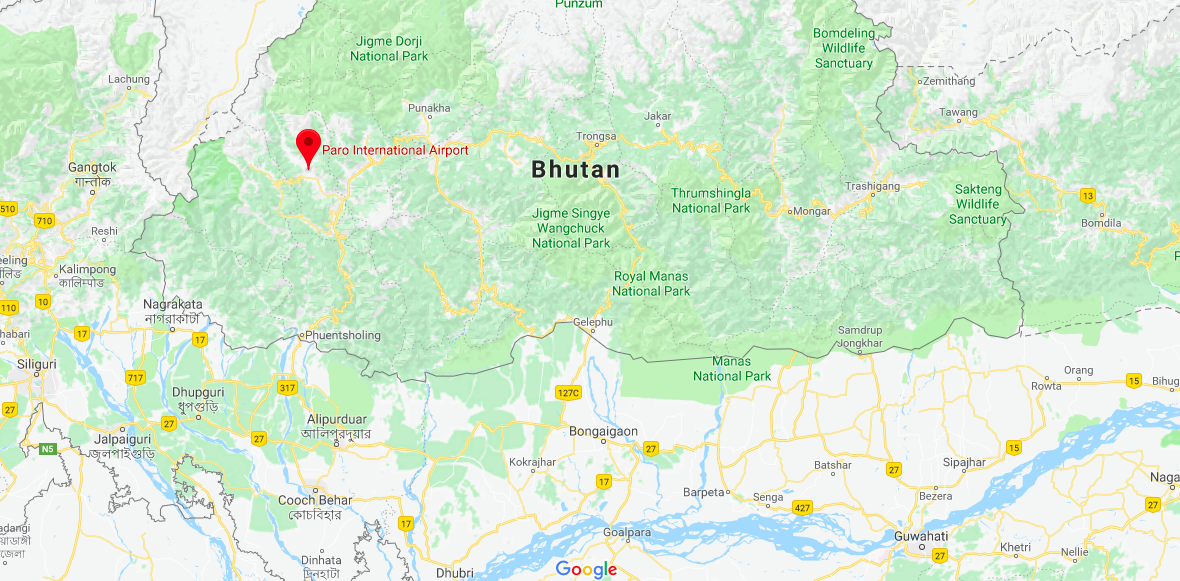
Getting to Paro, Bhutan
Direct flights from North America to Paro, Bhutan are not available. You will need to purchase a flight to a connecting city. Bangkok (BKK) is the preferred connecting city, but there may also be flights from New Delhi (DEL), Kathmandu (KTM), Singapore (SIN), Mumbai (BOM), or Kolkata (CCU).
Neary Travel will assist in arranging your flight from Bangkok, or your connecting city, to Paro with Druk Air or Bhutan Air. The cost of this flight is not included in the trip price and will be added to your trip invoice upon confirmation. The cost of a flight from Bangkok to Paro will likely cost between $700-$850 per person depending on what class is available. Flight costs may vary and are subject to change.
We recommend arriving to your connecting city at least one day early and spending the night. This will help you recover from any jet lag so you can take advantage of your first day in Bhutan.
Please do not purchase airfare until your departure has been confirmed by Neary Travel to have the minimum number of guests to operate the trip.
ESSENTIAL TRAVEL DOCUMENTS
Passports
If you don’t have a passport, apply for one immediately as the process can be lengthy. If you do have a passport, ensure it is valid for at least 6 months from your planned entry into Bhutan. Also, if you do not have at least two blank pages in your passport, we recommend that you apply to have extra pages added.
Keep your passport and/or customs form on your person while traveling. You may be asked for your papers at various times during the trip.
Bhutanese Visa
Our Bhutanese partner will arrange your tourist visa. We will send them a copy of your passport to begin the process. Prior to your trip, you will receive a visa clearance letter. You must have the letter in hand to check-in and board your Druk Air or Bhutan Air flight. You will receive your actual visa upon landing in Paro.
Visas for connecting flights in Thailand, Singapore and Nepal
No visa is required for stays less than 30 days in Thailand and for stays less than 90 days in Singapore. For Nepal, you may obtain a visa prior to travel from the Nepalese embassy (www.nepalembassyusa.org) or purchase a one-day, fifteen-day multiple-entry, one-month multiple-entry or three-month multiple-entry visa upon arrival at Tribhuvan International Airport in Kathmandu. Non-U.S. citizens should check with the consulates of each country for entry requirements.
Document Copies
Make copies of the photo page of your passport and of your Bhutanese visa. Obtain two spare passport photos. Carry these items separately from your passport in case they are lost or stolen. It is also a good idea to leave a copy of your passport and Bhutanese visa with your emergency contact at home. If your documents are lost or stolen, a photocopy will help the local U.S. consulate speed up replacement authorization.
Travel and Evacuation Insurance
Coverage for baggage loss, medical protection, trip cancellation, and trip interruption is highly recommended. Medical emergency evacuation insurance is also recommended. There are several insurance agencies to choose from. For a minimal policy, that fulfills an evacuation requirement, see www.travelinsure.com/what/imedhigh.asp.
TRIP DESCRIPTION
Accommodations/Meals
Our accommodations throughout Bhutan are clean and basic government standard 3-star hotels or lodges, with some 4- and 5-star accommodations at the conclusion of our journey. Most of the lodges have central heating and a few heat using wood stoves. During our two (2) camping nights, we will be in stand-up tents with cots.
All meals are hot and savory, with lots of choices of dishes. We will enjoy most of our meals in restaurants, with a picnic lunch or two throughout, and we have an excellent camp chef.
Transportation
On Druk Air/Bhutan Air, the checked baggage limit is 44 lbs. (20 kg.) The weight of your carry-on is part of your baggage allowance. There are also articles that may be carried free of charge over and above the free baggage allowance, such as a handbag, purse, book or overcoat. For a complete list, see www.drukair.com.bt
Ground transportation will be SUV, van or bus, depending on the size of the group.
Camp Life
On our camping nights, when you arrive at camp, your tents will be set up along with kitchen, dining, toilet and shower tents. As the camp staff cooks dinner, you will have time to relax and reflect on the day with your fellow traveling companions.
In the morning, the first wake-up call will let you know that hot beverages are ready. You can fill your mug and then begin to pack up your personal belongings and sleep gear as the crew prepares breakfast. After breakfast, the entire camp will be broken down and packing will be completed.
Meals
We provide a variety of Bhutanese, Indian, Chinese, and Western cuisine… and plenty of it! There are always hot drinks, and lots of vegetables. A day’s menu may include multiple-choice hot breakfasts and a buffet or picnic lunch with prepared salads. In the afternoons, we pause with hot tea and snacks. Dinners promise a feast of hot soup and several main entrees followed by dessert.
Dietary Restrictions
We need to know as soon as possible about any dietary requirements we should consider in planning your trip. If you have food allergies or restrictions, we will do our best to accommodate your needs. If you are a vegetarian or vegan and you let us know in advance, we can provide meals for you without additional cost. We cannot always provide for the same diversity or sophistication as our regular menu for dietary requests.
Beverages/Alcohol
Bottled water will be provided during the main portion of your tour and filtered/treated/boiled water on the camping portion. Sodas and alcohol will be available for purchase along the way and prior to the trip. Please note that there is a limited selection. Beer, wine and spirits/hard alcohol are of moderate quality. Beverages need to be in plastic or metal containers on the camping portion.
Drinking Water
We recommend you drink only bottled or previously boiled water and that you bring a refillable water bottle or similar device, especially when traveling away from major cities.
Rafting
Our rafting down the Mo Chhu will be in self-bailing paddle rafts, 15 feet in length. A guide calls commands and guide and guests paddle the raft as a team. The Mo Chhu is a Class II-III or “easy to moderate” rated river. You do not need any previous experience and it is a lovely way to spend a few hours and see the countryside.
The Portable Toilet
While the idea of camping is appealing to most people, many are inhibited or reluctant because of modesty or uncertainty. To minimize our impact, we use a portable toilet system that is set up each day at camp in a secluded location a discrete distance from tent sites. It is essentially a toilet without plumbing and is available from the time you arrive at camp each afternoon until you leave camp the next day. Toilet paper and a convenient hand-washing station are provided.
Bathing
We recommend using a liquid, biodegradable soap found in most stores that have a camping section or health food store. Disposable anti-bacterial towelettes are also a good idea.
Electricity
Bhutan is on the 220-240V, 50Hz cycles system. Sockets in Bhutan are types D, F and G. Plan to bring a converter for 110V devices and a selection of plug adapters. More information about plug types can be found at http://www.power-plugs-sockets.com/
Cameras
Water and dust can be a problem and it is a good idea to clean your camera every night with tissue, a brush and lens paper. We recommend you take out a rider on your homeowner’s policy to cover your camera, especially if it’s fine equipment. Don’t forget media cards, batteries and chargers. Disposable waterproof and panorama cameras are also a fun option.
Electronics & Technology
The use of electronic devices, especially music players, on your trip may represent an intrusion into the wilderness experience of your fellow guests. We ask that you please be mindful of the impacts to others and respect the wilderness nature of the trip. Please bring headphones if you intend to listen to music.
Common Courtesies
We request that you do not smoke in vehicles, at meals or in group situations. We have asked our guides, drivers, and staff who smoke to follow the same consideration.
Communication
Fax machines and telephones are available at the hotels, but can be expensive. Internet is available periodically in the lodges and hotels. The service is not great, but usually sufficient to check email.
If you are planning on taking your cell or smart phone, please check with your carrier regarding service in Bhutan. In the towns, cell coverage is reasonable. Everywhere else, it could be described as “hit or miss.”
If you have someone that needs to contact you about an emergency at home, they should call the Yangphel Office at the number provided. If possible, they will relay the message to you. Keep in mind it could be several hours, a day, or longer, before the message actually reaches you. For your family at home you should define for them what you consider an emergency and provide them with instructions to call the Yangphel office in the event one occurs during your trip.
Environmental Responsibility
We are an environmentally responsible company. On the trip, we carry out whatever we carry in, including non-biodegradable items such as batteries and empty plastic containers. Many areas of Bhutan where we will be visiting do not have the proper facilities to process this kind of waste, and your throwaways will end up in the river or tossed down a hillside. We suggest that you carry a large Ziploc bag in your pocket for daily accumulations, and empty it in our group trash bag on the nights we are away from civilization. As you pack for your trip, think about ways to minimize the trash that you will have to bring home. For example, take film out of paper containers, and take such things as your powdered drink mixes and “wash and dry” towelettes out of their foil packets and put them into reusable plastic containers.
Giving Gifts
We discourage handouts of candy and toys to the children you meet. “Junk food” is dangerous because dental care is almost non-existent in Bhutan, especially away from the towns. Handouts also encourage children to beg.
It is advisable to ask your Trip Leader to take you shopping to buy school supplies, etc. to give to children at appropriate times.
Money Matters
The official currency in Bhutan is the Ngultrum (BTN) and the current exchange rate is ~64 BTN to 1 US $. You will not need to take a great deal of money on the trip, just enough for any souvenirs you may buy, beverages, laundry and any snacks that are not covered in the cost of the trip. Anywhere from US$200-$500 should be enough, depending on how much shopping you like to do, plus an amount for any tips you may want to give the camp staff or Trip Leader (see Gratuities section).
Cash, ATM & Traveler’s Checks
We recommend exchanging cash for the local currency at the airport in Paro. There are a few ATM services that dispense local currency, but they are not reliable. Traveler’s checks can be awkward to exchange and are generally not the easiest way to carry money in Bhutan.
Credit Cards
You can often use credit cards in the larger town’s hotels, restaurants and stores. American Express, Visa and MasterCard are commonly accepted.
Shopping
Bhutan boasts talented indigenous artisans! Bhutan’s 13 traditional visual arts and crafts include paintings, wood carvings, sculptures, calligraphy, carpentry, gold, silver and blacksmithing, bamboo work, weaving and embroidering, pottery, masonry, paper making and incense. There is a lot of pride in their work and not a lot of bargaining done in Bhutan. Do not buy expensive items such as hand-woven silk fabrics without doing some comparative shopping and speaking with our Bhutanese partners and Trip Leader.
Weather & Climate
Bhutan is the same latitude as Miami, Florida. The climate varies widely with elevation, from tropical in the southern border areas, temperate in the inner central valleys, to alpine in the high Himalaya.
Average Temperatures in Fahrenheit for Nov (High/Low)
Paro (7300 ft.) Punakha (4200 ft.) Trongsa (7150 ft.) Bumthang (9150 ft.) 57⁰/35⁰ 73⁰/55⁰ 68⁰/44⁰ 61°/31° Average Temperatures in Fahrenheit for Feb (High/Low)
Paro (7300 ft.) Punakha (4200 ft.) Trongsa (7150 ft.) Bumthang (9150 ft.) 55⁰/35⁰ 66⁰/46⁰ 57⁰/33⁰ 50°/30° We will be passing through these towns from west to east. Temperatures should be relatively moderate and skies are usually brilliantly clear. As a general guideline, days will usually be sunny, cool to warm, and pleasant. Nights will be considerably cooler after the sun has set. Rain is possible. The temperature drops about 3.5°F for every 1,000 feet you gain in elevation, so daytime temperatures as we drive over the high passes will get chilly!
You may want to check one week prior to your trip for an up-to-date weather forecast.
Language
The three most common languages of Bhutan are English, Dzongkha and Nepali. Most people related to the tourism industry will speak English.
Laundry
Laundry service is available at the hotels and lodges. Many lodges do not have dryers and line dry laundry. It may be difficult to take advantage of the service due to our schedule, as your laundry may not be dry by the time you leave a lodge. Trongsa may be a town where we may get some laundry done. Your Trip Leader will help you coordinate any laundry needs.
Health/Medical Information
It’s important that we have your medical information for use by the leader in the field, and he or she may evacuate or disqualify you if necessary.
Please be aware that hospital facilities for serious medical problems may, at times, be a long way away, a doctor may not always be available, and evacuation can be prolonged, difficult, and expensive. Your trip leader does not carry prescription medications.
Despite the many precautions we all take to stay healthy, occasionally one may experience diarrhea. The major problem associated with this is fluid loss leading to severe dehydration, so it is important to maintain plentiful fluid intake. Avoid milk and caffeine, as it will only further dehydrate you. The best drinks are weak tea, mineral water and caffeine-free soft drinks. Ideally it is best to let diarrhea run its course. However you may want to bring over-the-counter medication to minimize your potential discomfort.
Staying Healthy
Never drink tap water in Bhutan. Drink bottled water and use this water to brush your teeth as well. Also, ask for no ice in your drinks because you can’t be sure it was made with boiled water. When eating at a restaurant, you’re probably safe eating thoroughly cooked items served to you while they’re still hot, but avoid raw vegetables, salads and shellfish to be extra cautious. You may eat fresh fruit that you peel yourself. The trip leader will provide you with more detailed guidelines.
At camp, trained, experienced camp staff hygienically prepares the food.
Immunizations
Bhutan’s rural areas below 5,577 ft., especially the southern belt districts along the border with India, may have malaria. Japanese Encephalitis may also exist, depending on the time of year. Therefore, we suggest obtaining a recommended chemoprophylaxis. Although we do not require any immunizations to participate, it is important that you be up-to-date on routine immunizations and that you check with your physician prior to departure. The CDC is a good resource for recommendations pertaining to international travel immunizations and will provide insight to the relevance of malaria, Japanese encephalitis and other topics associated with traveling in Bhutan.
Altitudes
Approximate altitudes of major towns:
Paro 7300 ft. Phobjikha 9800 ft.
Thimpu 7800 ft. Trongsa 7150 ft.
Punakha 4200 ft. Bumthang 9150 ft.
Approximate altitudes of major passes:
Dochu La 10,350 ft. Pele La 10,800 ft.
Sinchu La 11,400 ft. Yatong La 11,200 ft.
High Altitude
We design each of our trips for adequate altitude conditioning in the early part of the journey. However, be forewarned that there are no guarantees that your body will acclimatize properly. Any trip member who, in the opinion of the trip leader, shows signs of potential acute altitude sickness, such as HAPE (High Altitude Pulmonary Edema) will have no choice but to descend and remain at comfortable altitudes. The decision of the trip leader is final.
For Women Only
Even if you aren’t anticipating your menstrual period, come prepared for it. We recommend you bring some sandwich-size zip-lock bags. They can be used during the day can be disposed of when you reach your camp or lodge. Many women suggest bringing a small supply of baby wipes.
Time Zones
Bhutan is GMT +6 hours. If you are on the west coast USA, Bhutan is +14 hours ahead. For example:
8am PST = 10pm the following day, in Bhutan
GETTING READY
Physical Requirements
Our primary goal is for you to have an enjoyable experience. The nature of the trip is such that it involves some physical exertion and potential exposure to the elements, including cold water, heat, sun, wind and rain. We will be crossing passes as high as 10,000 ft. and almost 12,000 ft. The highest elevation we sleep is ~9800 ft. in Phobjikha. Activities include paddling, walking, and hiking to monasteries, dzongs and villages. Exercise at high altitude compounds physical stress. In addition, high altitude may create discomfort and symptoms of illness that you do not experience while exercising at lower elevations, such as shortness of breath, headaches, restlessness or sleeplessness at night. You need to be in good health and physical condition to enjoy such an experience, with adequate cardiovascular endurance, muscular strength and excellent balance.
We have experience accommodating people with a wide range of physical disabilities and/or health conditions. However, individuals who are overweight or lack conditioning can endanger themselves, other guests and the guides. Please consult your doctor if you have medical or health conditions that could impact your ability to participate in this outdoor adventure. In general, trip participants must be able to:
- Walk for an hour or two at a time with break.
- Navigate uneven terrain
- Carry a daypack
- Wear a Type V Coast Guard approved personal floatation devices (maximum chest size of 56 inches)
- Self-rescue by swimming and climbing into a boat or to shore in the event of an involuntary swim in a whitewater rapid
Physical Preparation
Due to the easy to moderate physical nature of this trip, we highly recommend that you engage in regular exercise for at least 3 months prior to departure to ensure preparedness. No gym membership required! Simple exercises like push-ups, sit-ups and squats go a long way to improving core fitness. Aerobic training is also easy to accomplish without expensive equipment. Take 30 – 40 minutes and go for a brisk walk, easy jog or bike ride around town two to three times a week. If you have access to a pool, lake or the ocean, swimming is obviously an ideal choice for aerobic exercise. It provides a full-body workout and is training that may come in handy in the event of an involuntary swim in a whitewater rapid. It is important to push yourself in the months leading up to your trip by increasing your strength training repetitions and the pace of your aerobic training. Getting in shape will certainly add to your enjoyment of the trip. Remember, our Bhutan adventure will be the trip of a lifetime. Let’s optimize your chances of enjoying it.
PACKING FOR YOUR TRIP
Clothing
You’ll need warm clothing for cold weather as it may get down to freezing at night. Pack warm weather things for the lower elevations where daytime temperatures reach into the 70’s. Expect mostly clear days and cold nights. Bring layers of synthetic or merino wool fabrics that insulate well, dry quickly and wick the perspiration away from your body.
In camp — When the weather is warm, lightweight cotton pants/skirt or shorts and shirt make great camp wear. Those so inclined may enjoy wearing a cotton skirt or sarong on warmer evenings. For cooler evenings, a dry set of synthetic or merino wool long underwear is the perfect base layer under long pants and a fleece sweater.
During the rafting portion – Start with a swimsuit and/or swim trunks and synthetic shirt as a base layer. You will be offered a wetsuit and splash jacket. Additional layers, like long underwear, fleece and rain gear, can be added and subtracted depending on the weather, temperature and how wet you’re getting in the rapids.
Footwear
In camp—We recommend wearing shoes in camp due to risk of kicking a rock buried in the ground, or stepping on a sharp stick. The athletic shoes or light hikers you bring for hiking can double as your camp shoes. It’s nice to put on dry socks and shoes after a day of sightseeing or walking. Flip-flops or “Crocs” are OK for wearing in camp only.
During the rafting—The best choice is an amphibious shoe that drains water, protects your toes and won’t come off in swirling current. Sport sandals with a heal strap or a retired pair of athletic shoes can work well.
Headwear
During the day—Wide-brimmed hats, caps or visors are a good choice for sun protection.
In camp—When the weather is cool, you’ll want a beanie-style hat to wear in camp. They are the perfect remedy for bed-head as you rise from your sleeping bag to secure your morning hot beverage, or for retaining warmth in the evening hours after the sun has set.
To Avoid Being Cold
Synthetic or merino wool long underwear is a great layer to have as an option. It can be worn under shorts, rain gear, T-shirts, etc., then stripped off when the chill of the morning has worn off. It keeps you warm even if it’s wet, dries quickly, and it’s compact enough to be stuffed into your daypack after you take it off. It can be layered under your waterproof rain jacket and pants. Note that cotton items, once wet, do not insulate; only synthetic and wool materials will keep you warm during cool, wet weather.
Something Warm for your Top & Bottom: Although the weather will probably be delightful, you need to be prepared for inclement weather. Bring a good fleece or wool top and bottom, along with a warm hat and gloves. You’ll want to double up on your synthetic or merino wool layers so that you’ll have a set to wear on the hike and a set of warm, dry clothes for camp.
Sun Protection
Protecting yourself from the sun should be taken very seriously! A sun hat, sunscreen, lip balm and sunglasses are a must. Also, it’s a good idea to have a long-sleeve shirt and lightweight long pants to cover up if you need a break from the sun. At the end of each day, you will want to have some good moisturizing lotion or cream to replenish your skin from the drying effects of the sun, wind and elements.
Bugs & Mosquitoes
Bugs and mosquitoes are generally not a problem on this trip; however we may see a few. We recommend bringing insect repellent.
Sleeping Gear
We provide sleeping bags and cots, but you may bring your own. We recommend a synthetic-fill bag rated to 20°F, the normal range for an all-around, “three-season” bag. Put your sleeping bag into a compression sack so that it takes less room in your duffle bag. We can also provide small pillows upon request
SUGGESTED PACKING LIST
Equipment and Personal Items:
- Sleeping bag: three season rated to 20°F (We provide, but you may bring your own.)
- Water bottle, heavy-duty, 1-liter
- Headlamp or flashlight
- Day pack
- Plastic bags – assorted zip-loc bags. Sunglasses, preferably polarized, with securing strap and a spare
- Small, quick-dry towel
- Toiletries
- Sunscreen, SPF 30+
- Lip protection, SPF 30+
- Moisturizing lotion
- Personal first aid kit – bandages, antibiotic ointment, ibuprofen, moleskin, eye drops, etc.
- Spare pair of glasses and/or contacts
- Cash for gratuities
Footwear:
- Athletic shoes or light hikers
- Extra pair of dry shoes/sandals for nighttime or camp (optional)
Clothing:
- One set of dressier casual clothes for travel & night in Thimpu or Paro
- Long pants and shirt good for walking, touring, hiking, touring or city wear
- Long-sleeved shirt
- Long pants
- Shade hat or visor with securing strap and a spare
- Waterproof rain jacket & pants
- Underwear
- Shorts
- T-shirts/tops
- Socks – for hiking, general touring
- Synthetic long underwear top & bottom: we recommend a minimum of 2 sets light to mid-weight
- Fleece or down/synthetic fill jacket
- Fleece pants
- Warm hat and gloves – synthetic or wool
- Swimsuit / Swim Trunks
Optional Items:
- Sarong – useful for sun protection/changing clothes
- Bathing wipes – pre-moistened disposable towels
- Binoculars
- Camera and accessories
- Sketchbook, Notebook and pen, paperback book
- A pocket knife – do not pack in your carry-on luggage
- Extra set of synthetic long underwear top and bottom – especially if you get cold easily
- Extra fleece top and down booties for camp
- Fleece or down/synthetic filled vest
- Swimsuit / Swim Trunks
Packing Your Gear
It’s always easier to travel light! Bring only what you need, and you will have less to haul around. Attire is very casual with comfort, convenience and space taking precedence over style. Bring only what is necessary to save time packing and repacking. Extra baggage can be an unwanted burden for yourself and others. Bhutan is a conservative country. Skimpy, revealing clothing is inappropriate for both sexes and only attracts unwelcome attention. Please bring loose, comfortable clothing.
For your main bag, bring a good quality duffel or other soft-sided luggage. You can bring a medium-sized daypack for hiking and as your carry-on for the flights.
Additional Baggage
You may leave a bag with our vehicle while you are on the camping portion. This bag will be available to you when you return.
Valuables
We recommend that you leave valuables at home.
Security While In Bhutan
Bhutan boasts very little crime. However, it is always wise to follow some simple safety precautions. When walking around towns, carry only a reasonable amount of spending money and a credit card. We recommend carrying a money belt or neck pouch as bags and purses attract attention.
Gratuities
Guests often ask whether gratuities are appropriate, and in what amount. If you feel your guides have provided a very special trip for you, a gratuity may be left with the trip leader who will divide the amount among the other guides, drivers, and camp staff. Hotel employees do not need to be tipped as the Trip Leader takes care of this. Entirely discretionary, we suggest 5%-10% of the trip price as a general tipping guideline. If you plan to tip, remember to bring cash for easy distribution.
TERMS AND CONDITIONS
Medical
- Under most circumstances, if you are of an adventurous spirit and in reasonably good health, you should have no problem enjoying this trip. People with medical conditions, including pregnancy, should have a physician’s approval before taking an adventure travel trip.
Insurance
- We recommend that you purchase medical evacuation insurance to participate in this expedition. Use your preferred insurance agency or call Travel Insurance Services at 800-937-1387 or visit their website at travelinsure.com/what/imedhigh.asp for inexpensive options that cover this requirement. We also strongly recommend that you protect yourself, your belongings, and your vacation through the purchase of a travel insurance plan. A travel insurance plan covers your non-refundable payments in most cases, should you have to cancel your trip due to illness or injury¬—yours or that of an extended family member—even at the last minute. Check that the plan you choose includes the required medical evacuation coverage mentioned above. Evacuations can be prolonged, difficult, and expensive. Personal belongings and cameras are carried entirely at the owner’s risk, and Neary Travel accepts no responsibility for lost, damaged, delayed or stolen property.
Liability Release
- Everyone is required to sign a standard liability release form before the trip, acknowledging awareness that there are inherent risks associated with the trip. Due to the nature of the activities, a condition of your participation is that you will sign this form and return it to our office before the trip begins. Anyone who refuses to sign the form will not be allowed to participate, and consistent with Neary Travel cancellation policy, there will be no refund of the trip fees at that time.
Responsibility – An Important Notice
- Neary Travel and Yangphel Adventure Travel, act only in the capacity of agent for the participants in all matters relating to transportation and/or all other related travel services, and assume no responsibility however caused for injury, loss or damage to person or property in connection with any service, including but not limited to that resulting directly or indirectly from acts of God, detention, annoyance, delays and expenses arising from quarantine, strikes, theft, pilferage, force majeure, failure of any means of conveyance to arrive or depart as scheduled, civil disturbances, government restrictions or regulations, and discrepancies or change in transit over which it has no control. Reasonable changes in itinerary may be made where deemed advisable for the comfort and well-being of the participants, including cancellation due to water fluctuation, insufficient bookings, (this trip requires a minimum of 6 guests), and other factors. There is risk in whitewater rafting, particularly during high-water conditions. Rafts and kayaks do capsize. You could be swept overboard. Your guide will make every attempt to assist, but you must be strong and agile enough to “self-help” and “float-it-out” without further endangering yourself or others. We reserve the right not to accept passengers weighing more than 260 pounds or with a waist/chest size exceeding 56 inches. We may decide, at any time, to exclude any person or group for any reason we feel is related to the safety of our trips. We are experienced at accommodating people with various disabilities. Please give us an opportunity to make you feel welcome. We need to discuss any special requirements ahead of time. On advancement of deposit the depositor agrees to be bound by the above recited terms and conditions. Prices subject to change without notice.
Affiliates
- Yangphel Adventure Travel, a travel partner of Neary Travel, will provide services including transportation and equipment on this trip. These international staff members are the very best and will strive to ensure your complete satisfaction.
-
Online Payment
To pay with debit or credit card using PayPal:
If you already have a PayPal account
- Visit paypal.me/NearyTravel
- Enter the amount to be paid –
- Payment 1 – Reservation, $2,850
- Payment 2 – Final Balance, $5,195
- Log in to your PayPal account
- Click on Payment Method and hit save
- Click Send Payment Now
If you do not have a PayPal account
- Visit paypal.me/NearyTravel
- Click on Sign Up
- Create your PayPal account
- Complete the above instructions
